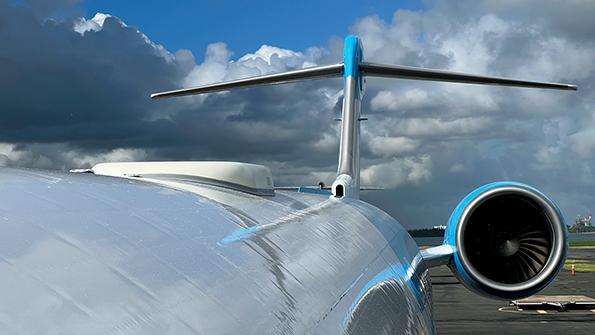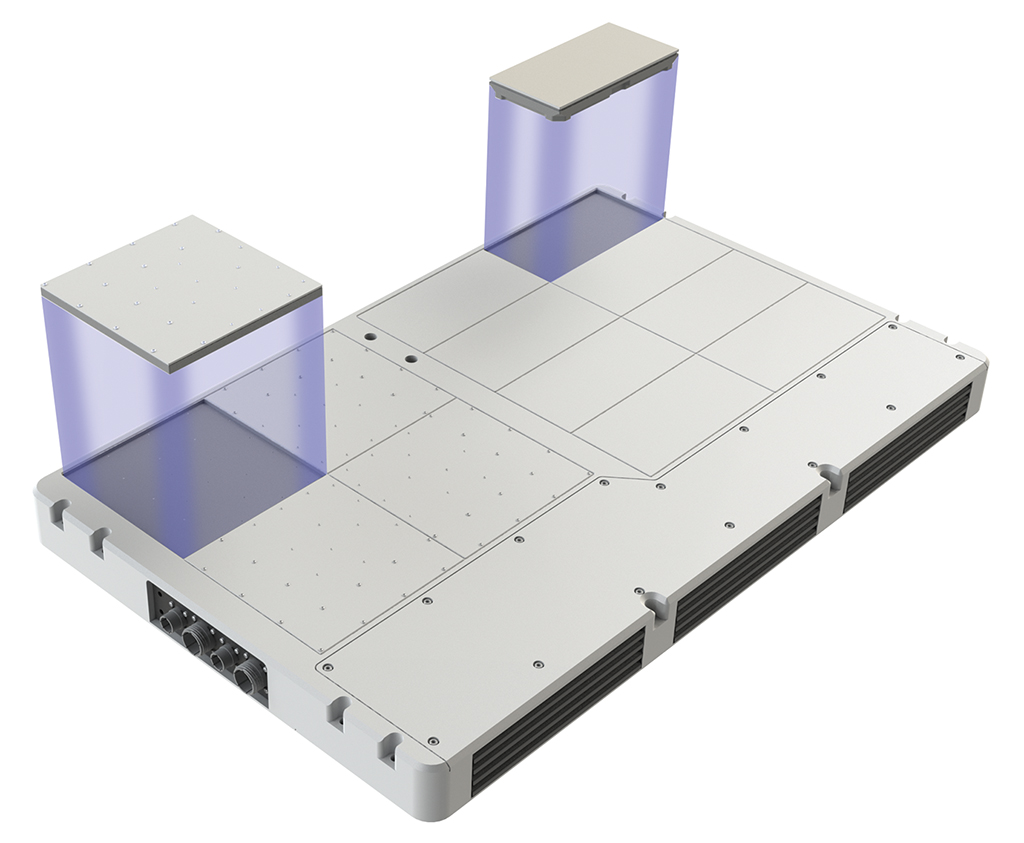Satellite Connectivity Advancements Drive Next-Gen Aircraft Antennas

The low-profile Sidewinder antenna installation, pictured on a regional jet, was designed for compatibility with any Ku constellation in any orbit.
Rising expectations for high-quality inflight entertainment systems are driving new developments for on-aircraft antennas.
The satellites facilitating this connectivity increasingly are non-geosynchronous orbit (NGSO) systems in low Earth orbit (LEO), medium Earth orbit (MEO) and high Earth orbit (HEO). On-aircraft antennas must be capable of working with all three orbit types as well as the legacy geosynchronous-orbit (GEO) constellations.
More than 4,000 active NGSO satellites are in operation, explains Bill Milroy, chairman and chief technology officer of ThinKom Solutions. He cites Euroconsult’s 2022 “Prospects for the Small Satellite Market,” which projects that an average of 1,846 NGSO satellites will be added annually through 2031.
“Other forecasts predict that [geosynchronous-orbit (GSO) systems] will continue to play a dominant role through the end of the decade,” Milroy says. “On this basis, we at ThinKom are emphasizing multi-orbit capabilities for our systems in order to bring the highest-efficiency connectivity via both GSO and NGSO constellations.”
To deliver on that, ThinKom’s ThinAir “variable-inclination continuous transverse stub (VICTS) phased-array mechanically steered antennas” incorporate low power and thermal dissipation, he says. VICTS’ patented technology also supports very wide instantaneous channel bandwidth—more than 500 MHz—which Milroy says is critical to operating effectively with many of the newer GSO and NGSO constellations.
“VICTS requires about 250-800 millisec. to complete an intersatellite switch,” Milroy says. “This is comparable to the longest ping times with NGSO systems and faster than the typical ping times for GSO satellites. We provide dual-beam variants for that subset of users who require simultaneous beam/satellite coverage.”
ThinKom’s VICTS antenna family includes the ThinAir Ka1717, its latest product, which was launched in 2022 at the Aircraft Interiors Expo in Hamburg. Milroy says the Ka1717 has been designed to meet the International Telecommunications Union Article 22 and World Radio Conference 5G Earth Station in Motion requirements to ensure the system does not interfere with GEO satellites when operating on NGSO networks or with 5G terrestrial networks that share the same Ka-band spectrum.
Milroy also notes that since small jets do not have the headliner space to house various terminal components, ThinKom introduced a new Ka1717 variant for regional jets at the Airline Passenger Experience show last September. For the regional jet variant, ThinKom eliminated two inside-aircraft equipment line replaceable units (LRU) and integrated the antenna controller and high-power amplifier functionality into the outside-aircraft equipment. “ThinKom was able to reduce the antenna subsystem weight, including the radome, adapter plate and fairing, by 50%,” he explains.
In a further development targeted to regional jets, Milroy says ThinKom and Carlisle Interconnect Technologies are collaborating on development and certification of a fully integrated Ka1717 package that includes the radome, adapter plate, fairing, power supply, connecting cables and installation kits. “The full satcom system, including installation hardware, connecting cables and in-cabin networking equipment, will be comfortably below 250 lb.,” he says.
Meanwhile, a new scanning, phased-array antenna providing 3.5+ GHz is being developed to provide full instantaneous channel bandwidth. Milroy says it will enable multiple simultaneous carriers and agile frequency hopping.

For the airline market, electronically steerable antennas (ESA) are the focus of Ball Aerospace, says Gary Raney, advanced systems manager for tactical solutions.
“ESAs are wired to support LEO networks due to their tracking capabilities,” Raney says. “And since they have a lower profile than existing mechanically steered antennas, they benefit smaller platforms that are focused on preserving their streamlined looks. We can even embed our antenna into a curved surface while maintaining a good field of coverage.” He also stresses that ESAs provide airlines with flexibility in working with network service providers so they do not have to work with one single vendor long-term.
Raney says Ball Aerospace’s ESA technology incorporates a software-defined aperture, enabling multi-orbit capabilities that allows users to switch among GEO, MEO and LEO orbit constellations as often as desired.
“Our ESAs have also been designed to support low-latency transitions between satellites,” Raney says. “Multi-orbit communication capabilities enabled by our ESAs let providers select the network they want, based on the latency needs and other network performance factors of the users they’re supporting.” He adds that the modular, scalable technology also enables a “commonality across multiple product lines,” allowing for a lower-profile and more reliable antenna than mechanically steerable options available today.
Raney notes that hardware and software challenges with antenna engineering have been driven by the extremely fast switching speeds and constant beam updates when operating on LEO networks. At the same time, he says the larger data rates require more bandwidth, creating additional difficulties in crafting the electronic components and antenna architectures.
“Ball Aerospace has overcome these issues by developing a highly integrated software-hardware approach within our ESAs,” Raney says. “By integrating necessary radio frequency functions into a single chip—a level of integration that has only recently become possible—we are enabling beam updates and can achieve the bandwidth and performance necessary using a smaller, cheaper antenna that requires less power.”
As the industry moves toward more robust, redundant and multi-orbit solutions, Stellar Blu Solutions (SBS) has created the Sidewinder in conjunction with OneWeb to support that company’s LEO services and the GEO services of OneWeb’s distribution partners.
Stephen Rice, vice president of business development at SBS, says that at the Sidewinder’s core is the Stellar Blu-designed antenna controller and management unit, which is integrated with aircraft systems and houses the frequency converter, radio frequency switch, modem, server and software developed in-house.
“The software controls the antenna, provides network selection and integrates with each distribution partner’s connectivity manager, as well as wireless internet service providers and inflight entertainment systems, as applicable,” Rice explains. He adds that the antenna incorporates core components from Ball Aerospace in a package designed by SBS to meet the robust performance, high reliability and ease of maintenance required by the airlines.
“Ball Aerospace produced the Ku- band subarrays, which are made up of semiconductors that are themselves small antennas,” Rice notes. “There are about 250 semiconductor elements in each roughly 6 X 6-in. subarray.”
Rice stresses that SBS is the terminal designer and OEM for the Sidewinder, incorporating parts that are SBS’ design and intellectual property. Those parts include six LRUs along with the system’s transmit antenna array and receive antenna array, which both use nine Ball subarrays.
“Sidewinder was designed for compatibility with any Ku constellation in any orbit,” Rice says. “The switch between beams, satellites and orbits is instantaneous and not noticeable to the end user, even with high-bandwidth applications like video calls. The single exception being the LEO-to-GEO switch, which can take several seconds, while the GEO-to-LEO switch is instantaneous.”
As an ESA, the Sidewinder can manage the frequent beam switches required with LEO constellations. “In the case of OneWeb, this switch can occur every 10-20 sec. in flight,” Rice says. “In fact, Sidewinder has been flight-tested at downlink speeds of nearly 300 Mbps on the OneWeb network and 200 Mbps on Intelsat.”
The Sidewinder has been designed as a “green” Satcom choice, too. “The top surface of the antenna is 3.6 in. above the fuselage crown—a lower profile and lower weight compared to other flat-panel and gimbal antennas, resulting in minimal fuel burn and CO2 emissions,” Rice explains. “Because it does not require a radome, it is as close to a conformal antenna as exists today.”
At the same time, Rice says no routine maintenance or inspection interval is required, since no radome is present. “With Stellar Blu’s cloud-based monitoring tool, antenna performance is tracked and maintenance can occur prior to any customer impact.”
Rice adds that Stellar Blu is developing supplemental type certificates for the Sidewinder on today’s most common commercial aircraft, with availability expected late this year. Alaska Airlines is the first announced customer, with application on subsidiary Horizon Air’s Embraer 175 fleet commencing in 2024.

For business aircraft, Satcom Direct (SD) formally announced its Plane Simple antenna series in February 2021. In February of this year, following a two-year testing, evaluation and qualification period, the tail-mounted Ku-band variant launched commercially, President Chris Moore says .
“The Plane Simple series is unique in that it incorporates three terminals, all of which have been purpose-built for business aviation,” Moore says. “They include the now-available Ku-band tail-mounted antenna connecting with Intelsat’s FlexExec network and the Ka-band tail-mounted antenna, which will be commercially introduced in the fourth quarter of this year. That will connect with the Inmarsat Jet ConneX network.” He notes that for either system, the weight on the tail is a maximum of 26.5 lb.
A fuselage-mounted ESA connecting with the OneWeb network is slated to be introduced in 2024, Moore adds.
“Plane Simple is the first network-integrated terminal designed exclusively for business aviation and not repurposed from other aviation sectors,” he notes. “There are just two LRUs—the SD Modem Unit and the tail-mounted antenna—connected by minimal cabling. This makes it easier to install, quicker to upgrade and supports flexible customized pricing plans.” Moore emphasizes that the system’s modular design enables minimally invasive upgrades, which also reduces downtime.
The Plane Simple ESAs are built on an open architecture and are designed to work with GEO and LEO constellations.
In a recent development, SD announced in February the start of validation testing of its “dual dissimilar technology,” which equips an aircraft with the Plane Simple Ku- and Ka-band tail-mounted antennas. “Dual” refers to the capability to work with two different—or “dissimilar”—satellite constellations. “We know that users are already installing two connectivity solutions, so we responded by providing the option to double up and increase the data consistency and amount of data transmitted,” he says.

